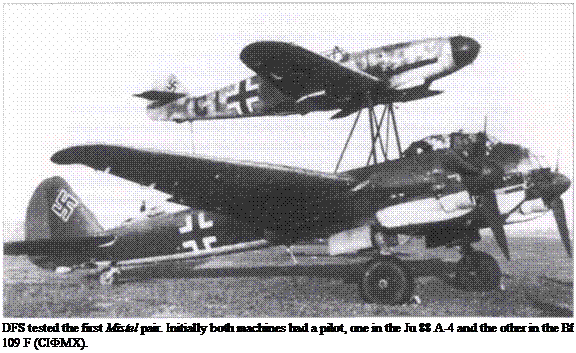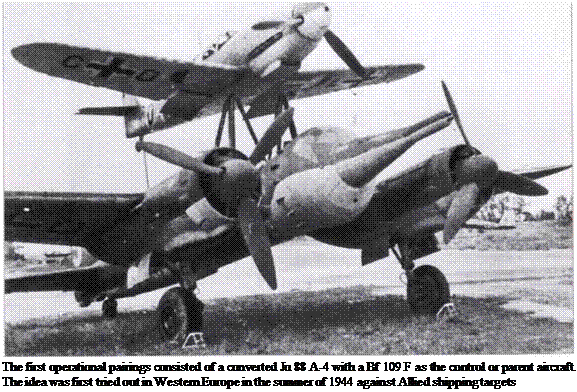Mistel Over. The Eastern Front
The search for the ultimate aircraft to destroy pin-point targets such as large road and rail bridges, power plants of all kinds and war factories resulted in numerous projects between 1943 and 1945. OKL wanted such aircraft initially to resist the Normandy landings, but later to destroy bridges of major importance and so protect the Reich borders. For all the long and intensive planning, however, they failed. A few hits were achieved but there was no possibility of turning the tide of events.

The idea of the Mistel originated with Flugkapitan Siegfried Holzbaur, who had an important role in flight testing for Junkers at Dessau. The idea of using
the Ju 88 A-4 as an unmanned large bomb was first considered seriously in the early summer of 1943.The arrangement involved a control aircraft, a Bf 109 F-4, riding on the upper central section of the bomber’s fuselage. Close to the target the Ju 88, armed with a 3.5-tonne bomb in the nose, would be detached and glide to the target under guidance. DFS flight-tested the first S-2 versions from the beginning of 1944. The first reliable data from July 1944 onwards showed that the wire-guided ‘Beethoven machine’ had enormous destructive power with a direct hit, but the relatively expensive construction and frequent problems in flight made the Mistel less ideal than at first thought.
Three versions were built and used by the war’s end:
|
Ml |
Ju 88 A-4 |
6c |
Bf 109 F-4 |
|
М2 |
Ju 88 G-l |
6c |
Fw 190 A-8 or F-8 |
|
M ЗА |
Ju 88 A-4 |
6c |
Fw 190 A-8 |
|
M3B |
Ju 88 G-l |
6c |
Fw 190 A-8 |
|
M3C |
Ju 88 G-10 |
6c |
Fw 190 F-8 |
Several other pairings were under consideration from 1944. Та 154a/Fw 190 A-8 was relatively well advanced and there were plans for He 177 А-5/Fw 190 A-9 or F-8, but only the Ju 88 combinations ever came to fruition. The high expenditure in costly material militated against the use of the 3.5-tonne special hollow charge – Luftwaffe arsenals had already begun extracting explosives from older bomb stocks to fill modern casings.
In January 1945 Mistel M 3B was in an advanced stage of research. The expendable bomber would have 1.5 tonnes of explosives in the nose. By 1 February 100 conversions, and by 10 February another 50, were in
hand. The production of the M 3B was held up for lack of Ju 88 G-ls, and only three complete pairs, and ten pathfinders equipped with remote control, left the Junkers works. Orders were in place for 150 special hollow-charge SHL 3500B bombs by 25 January at Riesa and another 100 by 10 February. The M 3B was in production during early February and the first pairs were due for delivery to KG 200 at the beginning of March. On 3 February Speer deferred the M 3C, which had a longer range than the M 3B, on the grounds of the shortage of Ju 88 G-lOs. On 14 February the Riistungsstab ordered the production of 50 Mistel able to fly 2,500 kilometres, and the resumption of the M 3C as soon as possible.
By 17 February 60 of 130 SHL 3500D bombs were ready and ten followed each day. The hollow charge had a mine and shrapnel effect. The first practical tests on 2 March were successful. As Allied jamming of remote guidance systems was expected, DFS had devised the Beethoven wire guidance system. On a test flight in which the Mistel pair did not separate, the command system worked flawlessly. A test with separation was scheduled for March, special importance being attached to the accuracy of the Beethoven system guiding the Ju 88 bomb.

Serious doubts about the Mistel manifested themselves from 15 March after attacks on bridges along the Eastern Front were not as successful as OKL had hoped. Numerous technical defects, the appearance of substantial numbers of Soviet fighters and heavy fire from the well-disciplined anti-aircraft batteries caused the premature abandonment of the majority of operations. Mistel development continued, however. From the beginning of March increasing numbers of Ju 88 G-lOs (Work Numbers Block 460) were test flown at Junkers particularly by Flugkapitane Harder and Dautzenberg. This aircraft was a lengthened Ju 88 G-6. The flight characteristics of the long version, as the Ju 88 H-l had shown, were not satisfactory, and the risks in flying a Ju 88 G-10/fighter combination were obviously greater than the Ju 88 G-l/ Fw 190 F-8. The last known movements recorded in surviving flight logs are for 30 March 1945. There were some Mistel pairs on the airfield at Barth at that time.
By mid-April doubts about the Mistel had increased, but the military situation was so desperate that all straws were being clutched at. Thus by the end of the
month all viable Mistel were on the Eastern Front, even if not too much was being expected of them.










